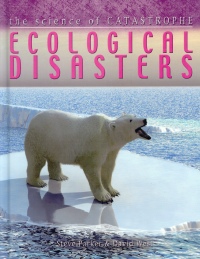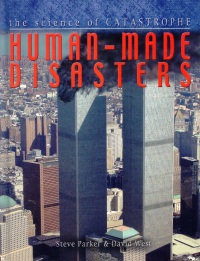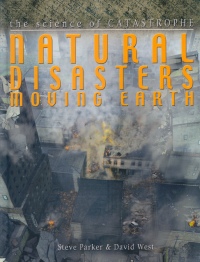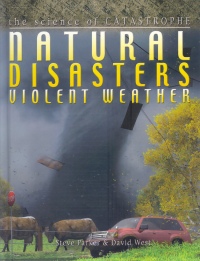| ________________
CM . . . . Volume XIX Number 11 . . . . November 16, 2012
excerpt:
Four titles comprise “The Science of Catastrophe” series which examines both natural and manmade disasters from a scientific perspective. Each title showcases 13 disasters from all parts of the world, with a double-page spread devoted to each. Most of the disasters are well-known types, such as avalanches and floods, but several might be new to readers, some examples being lahars, caldera collapse and lake overturn. The books’ layouts are identical: beneath the heading is a narrow black band on which is printed the location and date of the disaster, followed by a brief introduction. The main body of the text describes the specific incident while the scientific concept behind the disaster is explained in a text box along with a numbered diagram. Most of these diagrams are extremely helpful, and there are only a few which require the reader to make a connection on his or her own. One minor flaw in the series is that the referrals to previous and/or subsequent pages, listed in parentheses, disrupt the flow of the text. At the back of each book is a world map which shows the locations of the featured disasters as well as additional ones which are similar in nature. Other than the maps and the diagrams, the only illustrations are artists’ depictions of each disaster. One wonders why there are no actual photographs as, in most cases, they would be readily available. Words printed in boldface type appear in the glossary. A table of contents and an index are also provided. Ecological Disasters presents information about various environmental events (some occurring over long periods of time), from the actions which triggered them to the eventual consequences. All of the featured disasters are the result of human behaviour, ranging from tossing trash overboard at sea and polluting the air with chemicals from automobile and factory emissions to algal blooms and desertification. Topics in this title include the Dust Bowl of the 1930s, the oil spill in the Gulf of Mexico in 2010, the Great Chinese Famine which took place from 1958-1962, and the deforestation of the Amazon rain forest which began in the 1970s and continues to the present day. A few of the disasters (overfishing, the introduction of invasive species to habitats, and famine) caused food chains and food webs to collapse. One example is the Four Pests Campaign which happened during the Great Chinese Famine. People were encouraged to kill mosquitoes, flies, sparrows and rats, but with fewer sparrows to eat insects, the insects, particularly locusts, thrived and multiplied in huge numbers, damaging crops and upsetting the balance of nature. Human error is the basis for the catastrophes described in Human-Made Disasters. Equipment failure, an engineering miscalculation, the ignoring of safety rules and regulations, poor working conditions, and the failure of government officials to act in a timely manner to evacuate residents are just a few of the reasons for the tragedies which resulted in great loss of life and property. Readers likely will be familiar with the sinking of the Titanic, the terrorist attacks on the Twin Towers on 9/11, and perhaps even with the fiery crash of the Hindenburg airship, all of which are featured in this title. But they will also learn about lesser known tragedies, such as the boiler explosion in the Southern Pacific Railroad yard in Texas in 1912, during which the steam escaped with the force of a bomb, blowing nearby buildings away, smashing windows for blocks and causing the boiler to end up three blocks away. Mining, nuclear reactor and several industrial accidents, dam failure, a space shuttle explosion, bridge collapse in Minneapolis and a Russian submarine disaster are covered as well. Also discussed is an unusual airliner crash in Greece in 2005. A ground engineer neglected to switch the air pressure back to the “automatic” setting, and, as air pressure inside the craft fell, the pilots lost consciousness. Despite attempts by another crew member to operate the controls, both engines failed and the plane crashed into the side of a mountain, killing all of the 121 people on board. Though there have been many books written about the powerful forces of nature in relation to volcanic eruption and earthquakes, Natural Disasters: Moving Earth provides information about a few lesser known types of earth-related disasters. Some examples of these include the 2010 cliff collapse in St. Lucia where rocks, undercut by erosion, broke apart and fell, taking down dozens of dwellings and killing 70 people; the 1997 pyroclastic flow from one of Montserrat’s volcanoes which destroyed the airport, decimated the tourist industry and made more than half of the island unsuitable for habitation; Colombia’s 1985 lahars (volcanic outpourings mixed with water, resembling freshly-mixed concrete) that, moving at 65 kilometers per hour, destroyed towns and villages, resulting in 23,000 deaths; and the extremely rare phenomenon called a lake overturn which occurred in Lake Nyos, Cameroon, in 1986. A lake overturn, also known as an “exploding lake” or outgassing, requires special conditions. In the case of the tragedy at Lake Nyos, carbon dioxide dissolved in water near the lake bed, and one theory is that a landslide within the lake disturbed the site, causing the waters to swirl to the surface and fizz upward like a shaken carbonated beverage. More than 1,700 people and animals from three different communities perished from breathing in the deadly carbon dioxide gas which formed a fast-moving cloud that stretched over 25 kilometers. Other disasters in this title include an avalanche, a mudslide, a volcanic eruption, a fault-slip earthquake, a subduction quake-tsunami, a tsunami, a caldera collapse and an asteroid impact. Natural Disasters: Violent Weather highlights many extreme weather phenomena with which most readers are familiar. Perhaps the best known is Hurricane Katrina which, in August of 2005, barreled through America’s Gulf Coast, leaving 80 per cent of the city of New Orleans covered with water and causing 1,800 deaths from the hurricane and the flooding. In this title, there is information about thunderstorms, microbursts (short-lived mini-tornadoes that are capable of picking up cars and people and causing airplanes to crash), hailstorms, cyclones, tornadoes, waterspouts, superstorms, floods and blizzards. Readers will also learn about a severe sandstorm that took place in northwestern Iraq in 2009, coating the area in sand and dust and resulting in Baghdad’s transportation schedules, from airplanes to trains and buses, being canceled or disrupted. Western Europe’s mid-July heatwave in 2003, which caused water shortages, crop failures, electricity outages and more than 40,000 deaths, and Australia’s 2009 lightning and wildfires which resulted in the destruction of more than 2,000 homes and the displacement of 8,000 people, are also covered. One minor flaw in this title is the omission of ice storms in the list of topics. (Of note is Québec’s ice storm in January of 1998 during which homes, roads and power lines were thickly coated with ice. As a result of massive power outages, many parts of the province were without power for three weeks, and 16,000 Canadian soldiers assisted in disaster relief efforts, the largest peacetime deployment in Canada’s history.) With only two pages devoted to each disaster, it is impossible to provide a great deal of detailed information. However, this series would make a good supplement to an existing collection of books on the various topics. Recommended. Gail Hamilton is a former teacher-librarian in Winnipeg, MB.
To comment
on this title or this review, send mail to cm@umanitoba.ca.
Copyright © the Manitoba Library Association. Reproduction for personal
use is permitted only if this copyright notice is maintained. Any
other reproduction is prohibited without permission.
NEXT REVIEW |
TABLE OF CONTENTS FOR THIS ISSUE
- February 10, 2012.
AUTHORS |
TITLES |
MEDIA REVIEWS |
PROFILES |
BACK ISSUES |
SEARCH |
CMARCHIVE |
HOME |



